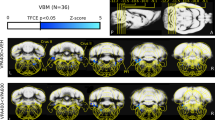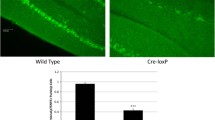Abstract
Neural abnormalities commonly associated with autism spectrum disorders include prefrontal cortex (PFC) dysfunction and cerebellar pathology in the form of Purkinje cell loss and cerebellar hypoplasia. It has been reported that loss of cerebellar Purkinje cells results in aberrant dopamine neurotransmission in the PFC which occurs via dysregulation of multisynaptic efferents from the cerebellum to the PFC. Using a mouse model, we investigated the possibility that developmental cerebellar Purkinje cell loss could disrupt glutamatergic cerebellar projections to the PFC that ultimately modulate DA release. We measured glutamate release evoked by local electrical stimulation using fixed-potential amperometry in combination with glutamate selective enzyme-based recording probes in urethane-anesthetized Lurcher mutant and wildtype mice. Target sites included the mediodorsal and ventrolateral thalamic nuclei, reticulotegmental nuclei, pedunculopontine nuclei, and ventral tegmental area. With the exception of the ventral tegmental area, the results indicated that in comparison to wildtype mice, evoked glutamate release was reduced in Lurcher mutants by between 9 and 72 % at all stimulated sites. These results are consistent with the notion that developmental loss of cerebellar Purkinje cells drives reductions in evoked glutamate release in cerebellar efferent pathways that ultimately influence PFC dopamine release. Possible mechanisms whereby reductions in glutamate release could occur are discussed.





Similar content being viewed by others
References
American Psychiatric Association. Diagnostic and statistical manual of mental disorders-IV-TR. 4th ed. Washington: American Psychiatric Association; 2000.
Ozonoff S, South M, Provencal S. Executive functions in autism: theory and practice. In: Pérez JM, GonzálezPM MC, Comí MC, et al., editors. New developments in autism: the future is today. Philadelphia: Asociación de Padres de Personas con Autismo; 2007. p. 185–213.
Centers for Disease Control and Prevention. Prevalence of autism spectrum disorders— Autism and Developmental Disabilities Monitoring Network, 14 sites, United States, 2002. MMWR 56(No. SS-1), 12–28, 2007.
Bauman ML. Microscopic neuroanatomic abnormalities in autism. Pediatrics. 1991;87:791–6.
Bolduc M, Du Plessis AJ, Sullivan N, Khwaja OS, Zhang X, Barnes K, et al. Spectrum of neurodevelopmental disabilities in children with cerebellar malformations. Dev Med Child Neurol. 2011;53:409–16.
Courchesne E. Brainstem, cerebellar and limbic neuroanatomical abnormalities in autism. Curr Opin Neurobiol. 1997;7:269–78.
Courchesne E, Townsend J, Akshoomoff NA, Saitoh O, Yeung-Courchesne R, Lincoln AJ, et al. Impairment in shifting attention in autistic and cerebellar patients. Behav Neurosci. 1994;108:848–65.
Courchesne E, Yeung-Courchesne R, Press GA, Hesselink JR, Jernigan TL. Hypoplasia of cerebellar vermal lobules VI and VII in autism. N Engl J Med. 1988;318:1349–54.
DiCicco-Bloom E, Lord C, Zwaigenbaum L, Courchesne E, Dager SR, Schmitz C, et al. The developmental neurobiology of autism spectrum disorder. J Neurosci. 2006;26:6897–906.
Limperopoulos C, Chilingaryan G, Sullivan N, Guizard N, Robertson RL, du Plessis AJ. Injury to the premature cerebellum: outcome is related to remote cortical development. Cereb Cortex. 2012, Nov 11.
Palmen SJ, van Engeland H, Hof PR, Schmitz C. Neuropathological findings in autism. Brain. 2004;127:2572–83.
Whitney ER, Kemper TL, Bauman ML, Rosene DL, Blatt GJ. Cerebellar Purkinje cells are reduced in a subpopulation of autistic brains: a stereologic experiment using calbindin-D28k. Cerebellum. 2008;7:406–16.
Whitney ER, Kemper TL, Rosene DL, Bauman ML, Blatt GJ. Calbindin-D28k is a more reliable marker of human Purkinje cells than standard Nissl stains: a stereological experiment. J Neurosci Methods. 2008;168:42–7.
Carper RA, Courchesne E. Inverse correlation between frontal lobe and cerebellum sizes in children with autism. Brain. 2000;2000(123):836–44.
Courchesne E, Mouton PR, Calhoun ME, Semendeferi K, Ahrens-Barbeau C, Hallet MJ, et al. Neuron number and size in prefrontal cortex of children with autism. JAMA. 2011;306:2001–10.
Ernst M, Zametkin AJ, Matochik JA, Pascualvaca D, Cohen RM. Low medial prefrontal dopaminergic activity in autistic children. Lancet. 1997;350:638.
Caddy KW, Biscoe TJ. Structural and quantitative studies on the normal C3H and Lurcher mutant mouse. Philos Trans R Soc Lond B Biol Sci. 1979;287:167–201.
Zuo J, De Jager PL, Takahashi KA, Jiang W, Linden DJ, Heintz N. Neurodegeneration in Lurcher mice caused by mutation in delta2 glutamate receptor gene. Nature. 1997;388:769–73.
Goldowitz D, Moran H, Wetts R. Mouse chimeras in the study of genetic and structural determinants of behavior. In: Goldowitz D, Wahlsten D, Wimer RE, editors. Techniques for the genetic analysis of brain and behavior: focus on the mouse. Amsterdam: Elsevier; 1992. p. 271–90.
Dickson PE, Rogers TD, Del Mar N, Martin LA, Heck D, Blaha CD, et al. Behavioral flexibility in a mouse model of developmental cerebellar Purkinje cell loss. Neurobiol Learn Mem. 2010;94:220–8.
Martin LA, Goldowitz D, Mittleman G. Repetitive behavior and increased activity in mice with Purkinje cell loss: a model for understanding the role of cerebellar pathology in autism. Eur J Neurosci. 2010;31:544–55.
Chudasama Y, Passetti F, Rhodes SE, Lopian D, Desai A, Robbins TW. Dissociable aspects of performance on the 5-choice serial reaction time task following lesions of the dorsal anterior cingulate, infralimbic and orbitofrontal cortex in the rat: differential effects on selectivity, impulsivity and compulsivity. Behav Brain Res. 2003;146:105–19.
Robbins TW, Arnsten AF. The neuropsychopharmacology of fronto-executive function: monoaminergic modulation. Annu Rev Neurosci. 2009;32:267–87.
Mittleman G, Goldowitz D, Heck DH, Blaha CD. Cerebellar modulation of frontal cortex dopamine release in mice: relevance to autism and schizophrenia. Synapse. 2008;62:544–50.
Schwarz C, Schmitz Y. Projection from the cerebellar lateral nucleus to precerebellar nuclei in the mossy fiber pathway is glutamatergic: a study combining anterograde tracing with immunogold labeling in the rat. J Comp Neurol. 1997;381:320–34.
Vertes RP, Martin GF, Waltzer R. An autoradiographic analysis of ascending projections from the medullary reticular formation in the rat. Neuroscience. 1986;19:873–98.
Oakman SA, Faris PL, Cozzari C, Hartman BK. Characterization of the extent of pontomesencephalic cholinergic neurons’ projections to the thalamus: comparison with projections to midbrain dopaminergic groups. Neuroscience. 1999;94:529–47.
Lavoie B, Parent A. Pedunculopontine nucleus in the squirrel monkey: distribution of cholinergic and monoaminergic neurons in the mesopontine tegmentum with evidence for the presence of glutamate in cholinergic neurons. Comp Neurol. 1994;344:190–209.
Middleton FA, Strick PL. Basal ganglia and cerebellar loops: motor and cognitive circuits. Brain Res Brain Res Rev. 2000;31:236–50.
Middleton FA, Strick PL. Cerebellar projections to the prefrontal cortex of the primate. J Neurosci. 2001;21:700–12.
Pinto A, Jankowski M, Sesack SR. Projections from the paraventricular nucleus of the thalamus to the rat prefrontal cortex and nucleus accumbens shell: ultrastructural characteristics and spatial relationships with dopamine afferents. J Comp Neurol. 2003;459:142–55.
Pirot S, Jay TM, Glowinski J, Thierry AM. Anatomical and electrophysiological evidence for an excitatory amino acid pathway from the thalamic mediodorsal nucleus to the prefrontal cortex in the rat. Eur J Neurosci. 1994;6:1225–34.
Rogers TD, Dickson PE, Heck DH, Goldowitz D, Mittleman G, Blaha CD. Connecting the dots of the cerebro-cerebellar role in cognitive function: neuronal pathways for cerebellar modulation of dopamine release in the prefrontal cortex. Synapse. 2011;65:1204–12.
Rogers TD, Dickson PE, McKimm E, Heck D, Goldowitz D, Blaha C, et al. Developmental cerebellar damage in two mouse models: relevance to the neuropathology of autism. Cerebellum. 2013;12:547–56.
Agnesi F, Blaha CD, Lin J, Lee KH. Local glutamate release in the rat ventral lateral thalamus evoked by high-frequency stimulation. J Neural Eng. 2010;7:1–11.
Agnesi F, Tye SJ, Bledsoe JM, Griessenauer CJ, Kimble CJ, Sieck GC, et al. Wireless instantaneous neurotransmitter concentration system-based amperometric detection of dopamine, adenosine, and glutamate for intraoperative neurochemical monitoring. J Neurosurg. 2009;111:701–11.
Paxinos G, Franklin KBJ. The mouse brain in stereotaxic coordinates 2nd ed. San Diego: Academic; 2001.
Tehovnik EJ. Electrical stimulation of neural tissue to evoke behavioral responses. J Neurosci Methods. 1996;65:1–17.
Yeomans JS, Maidment NT, Bunney BS. Excitability properties of medial forebrain bundle axons of A9 and A 10 dopamine cells. Brain Res. 1988;450:86–93.
Carder RK, Hendry SH. Neuronal characterization, compartmental distribution, and activity-dependent regulation of glutamate immunoreactivity in adult monkey striate cortex. J Neurosci. 1994;14:242–62.
Arckens L, Schweigart G, Qu Y, Wouters G, Pow DV, Vandesande F, et al. Cooperative changes in GABA, glutamate and activity levels: the missing link in cortical plasticity. Eur J Neurosci. 2000;12:4222–32.
Andreasen NC, Paradiso S, O’Leary DS. “Cognitive dysmetria” as an integrative theory of schizophrenia: a dysfunction in cortical-subcortical-cerebellar circuitry. Schizophr Bull. 1998;24:203–18.
Kyriakopoulos M, Vyas NS, Barker GJ, Chitnis XA, Frangou S. A diffusion tensor imaging study of white matter in early onset schizophrenia. Biol Psychiatry. 2008;63:519–23.
Maloku E, Covelo IR, Hanbauer I, Guidotti A, Kadriu B, Hu Q, et al. Lower number of cerebellar Purkinje neurons in psychosis is associated with reduced reelin expression. Proc Natl Acad Sci U S A. 2010;107:4407–11.
Magnotta VA, Adix ML, Caprahan A, Lim K, Gollub R, Andreasen NC. Investigating connectivity between the cerebellum and thalamus in schizophrenia using diffusion tensor tractography: a pilot study. Psychiatry Res. 2008;163:193–200.
Heckroth JA. Quantitative morphological analysis of the cerebellar nuclei in normal and lurcher mutant mice. I. Morphology and cell number. J Comp Neurol. 1994;343:173–82.
Heckroth JA. A quantitative morphological analysis of the cerebellar nuclei in normal and lurcher mutant mice. II. Volumetric changes in cytological components. J Comp Neurol. 1994;343:183–92.
Strazielle C, Lalonde R, Reader TA. Autoradiography of glutamate receptor binding in adult Lurcher mutant mice. J Neuropathol Exp Neurol. 2000;59:707–22.
Lee M, Schwab C, McGeer PL. Astrocytes are GABAergic cells that modulate microglial activity. Glia. 2011;59:152–65.
Shimmura C, Suzuki K, Iwata Y, Tsuchiya KJ, Ohno K, Matsuzaki H, et al. Enzymes in the glutamate-glutamine cycle in the anterior cingulate cortex in postmortem brain of subjects with autism. Mol Autism. 2013;4:6.
Horder J, Lavender T, Mendez MA, O’Gorman R, Daly E, Craig MC, et al. Reduced subcortical glutamate/glutamine in adults with autism spectrum disorders: a [1H]MRS study. Transl Psychiatry. 2013;3:e279.
Acknowledgments
This project was made possible by NINDS grant 1R01NS063009.
Conflict of Interest
There are no conflicts of interest.
Author information
Authors and Affiliations
Corresponding author
Rights and permissions
About this article
Cite this article
McKimm, E., Corkill, B., Goldowitz, D. et al. Glutamate Dysfunction Associated with Developmental Cerebellar Damage: Relevance to Autism Spectrum Disorders. Cerebellum 13, 346–353 (2014). https://doi.org/10.1007/s12311-013-0541-4
Published:
Issue Date:
DOI: https://doi.org/10.1007/s12311-013-0541-4




